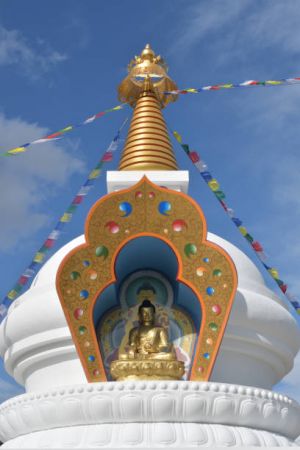Bija
[[File:Om siddham.png|thumb|right|100px|The Om bija in Esoteric Buddhism)]
In Hinduism and Buddhism, the Sanskrit term बीज Bīja (Jp. 種子 shuji), literally seed, is used as a metaphor for the origin or cause of things and cognate with bindu.
The metaphor is considerably extended in the Consciousness-only teachings of the Yogacara school of Buddhism. According to this theory, all experiences and actions produce Bīja as impressions, stored in the Alaya storehouse consciousness. The external world is produced when the
seeds "perfume" this consciousness. This view of Bīja has been equated to memes, with the theory itself positing an extreme form of memetics (i.e. reality and existence consist purely of memes).
In Vajrayana Buddhism and Hinduism, the term Bīja is used for mystical "seed syllables" contained within mantras. These seeds do not have precise meanings, but are thought to carry connections to spiritual principles. The best-known Bīja syllable is Om, first found in the Hindu scriptures the Upanishads.
Khanna (2003: p. 21) links mantras and yantras to thoughtforms:
- Mantras, the Sanskrit syllables inscribed on yantras, are essentially 'thought forms' representing divinities or cosmic powers, which exert their influence by means of sound-vibrations.
In some tantric traditions, the Bija of the 'Varnamala' (Sanskrit; English: "garland of letters"; which may be rendered as alphabet) are understood as aniconic representations and sound embodiments of the matrikas (a group of goddesses).
In Tibetan Buddhism the seed syllables corresponding to the Three Vajras are: a white oṃ (enlightened body), a red āḥ (enlightened speech) and a blue hūṃ (enlightened mind).
In the Bön tradition of Tibet, it's a little different: a white āḥ, a red oṃ and a blue hūṃ.
Bijas are often the vehicle of esoteric transmission of terma to a 'terton' (Tibetan; English: "revealer of terma"), such as that experienced by Dudjom Lingpa.
Cross cultural correlates
Guruwari of the Indigenous Australian peoples is an interesting cross cultural correlate and may be cognate. See also gankyil of the Vajrayana tradition which is cognate with bindu. In the respected fieldwork published in Aboriginal Men of High Degree, A.P. Elkin cites what he in his professional opinion is evidence that traders from Indonesia brought fleeting contact of Buddhism and Hinduism to areas near modern-
day Dampier. Traditions of Mantrayana were also evident in Indonesia, e.g. Candi Sukuh. And it is in the Vajrayana and Mantrayana traditions of esoteric transmission where bija take precedence. Indeed, bija defines Mantrayana. Elkin interpreted a link between Indigenous
Australian culture and Buddhist ideas such as reincarnation. He argued this link could have been brought through contact with Macassan traders. There was also speculation due to reports of Chinese relics appearing in northern Australia dating to the 15th century, although it may have been
brought much later through trade rather than earlier exploration. Elkin cited linguistic commonalities of certain far northern Australian indigenous words and lexical items and ancient southern Indian Dravidian languages. There are also documented analogues and marked similarities in their kinship systems.

